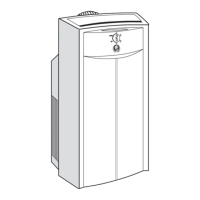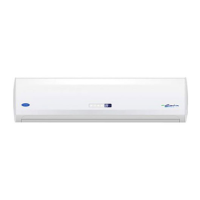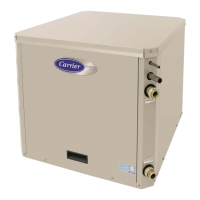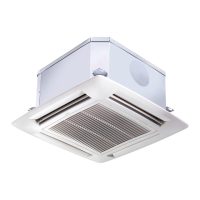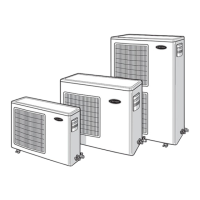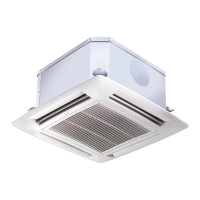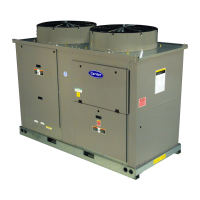What to do if my Carrier GR-45 Air Conditioner shows high voltage?
- AAlan BaileyAug 18, 2025
If the battery voltage is higher than 32 volts, it indicates high voltage. You should check, repair, or replace the alternator.
What to do if my Carrier GR-45 Air Conditioner shows high voltage?
If the battery voltage is higher than 32 volts, it indicates high voltage. You should check, repair, or replace the alternator.
How to fix a Carrier GR-45 Air Conditioner breaker trip alarm?
If a breaker on the relay board has tripped or a fan relay has failed, it can cause a breaker trip alarm. Check the breakers to see if any have tripped. Repair any shorts and then reset the breaker.
What causes low voltage in a Carrier GR-45 Air Conditioner?
If the battery voltage is less than 17 volts, it means there is low voltage. Check, repair, or replace the wiring or alternator.
How to troubleshoot a Carrier GR-45 motor failure?
A brushless motor may not have reached full operating speed or the motor has failed. Replace the motor or correct the pressure shutdown.
What to do if the Carrier GR-45 evaporator fan is overloaded?
The evaporator fan overload jumper is open. Ensure the connector is plugged in or repair the wiring.
How to fix a Carrier GR-45 condenser fan overload?
The condenser fan overload jumper is open. Ensure the connector is plugged in or repair the wiring.
What does Maintenance Alarm 1 mean on my Carrier GR-45?
The compressor hour meter is greater than the value in Maintenance Hour Meter 1. Reset the maintenance hour meter.
What does Maintenance Alarm 2 mean on my Carrier GR-45?
The evaporator hour meter is greater than the value in Maintenance Hour Meter 2. Reset the maintenance hour meter.
What causes a Return Air Probe Failure in Carrier GR-45?
The return air temperature sensor has failed, or the wiring is defective. Ensure all connectors are plugged in, and then check the sensor resistance or wiring. Replace the sensor or repair the wiring.
How to troubleshoot a Suction Pressure Transducer Failure in Carrier GR-45 Air Conditioner?
The suction pressure transducer has failed or the wiring is defective. Ensure all connectors are plugged in, and then check the sensor voltage or wiring. Replace the sensor or repair the wiring.
Essential safety precautions for operation and maintenance of the equipment.
Immediate actions for injuries sustained during operation or maintenance.
Guidelines to ensure safe operation of the equipment.
Safety measures for performing maintenance tasks.
Critical alerts regarding system hazards and procedures.
Overview of the manual and system components.
Overview of the bus air conditioning system.
Technical details of system components like refrigerant and compressor.
Electrical data for evaporator and condenser motors.
Specifications for pressure and temperature sensors.
Overview of system protection devices.
Explanation of air movement paths through the system.
Description of the cooling process.
Description of the heating system operation.
Description of the relay board for motor control (Option 1).
Relay functions for Option 2 motor control.
Description of the logic board and its interfaces.
Overview of the Micromate control panel interface.
Procedures for system operation, starting, and stopping.
Essential checks to perform before operating the unit.
Explanation of the different system operating modes.
Using the Micromate for system diagnostics and testing.
Logic board self-test error codes and interpretation.
Overview of system alarms, codes, and indicators.
General guidance for resolving system issues.
Causes and remedies for a system that will not cool.
Causes and remedies for poor cooling performance.
Troubleshooting high or low system pressures.
Identifying and fixing abnormal noise or vibration issues.
Diagnosing and resolving control logic failures.
Causes and remedies for low or no evaporator air flow.
Troubleshooting issues related to the expansion valve.
Identifying and resolving heating system problems.
Recommended maintenance tasks and intervals.
Procedure to access internal components by opening the top cover.
Description and function of the suction and discharge service valves.
Steps to connect pressure gauges to the system.
Procedures for managing refrigerant, including pump down and removal.
Methods for detecting refrigerant leaks in the system.
Process for removing moisture and air from the system.
Procedures for charging the system with refrigerant.
Method to detect non-condensable gases in the system.
Procedure for testing and replacing the high pressure switch.
Description and service procedures for the filter-drier.
Procedure for replacing the condenser coil assembly.
Procedure for replacing the evaporator coil assembly.
Maintenance and repair of the heat valve.
Maintenance and repair of the liquid line solenoid valve.
Procedures for removing, inspecting, and cleaning the fan/motor assembly.
Steps to replace the evaporator fan unit.
Procedure for changing the vehicle's return air filters.
Description of the TXV's function and maintenance requirements.
General maintenance procedures for the compressor.
How to test temperature sensors for accuracy.
How to test pressure transducers for accuracy.
Procedure for replacing faulty sensors or transducers.
Setting configuration jumpers on a replacement logic board.
Overview of electrical wiring diagrams and configurations.
Essential safety precautions for operation and maintenance of the equipment.
Immediate actions for injuries sustained during operation or maintenance.
Guidelines to ensure safe operation of the equipment.
Safety measures for performing maintenance tasks.
Critical alerts regarding system hazards and procedures.
Overview of the manual and system components.
Overview of the bus air conditioning system.
Technical details of system components like refrigerant and compressor.
Electrical data for evaporator and condenser motors.
Specifications for pressure and temperature sensors.
Overview of system protection devices.
Explanation of air movement paths through the system.
Description of the cooling process.
Description of the heating system operation.
Description of the relay board for motor control (Option 1).
Relay functions for Option 2 motor control.
Description of the logic board and its interfaces.
Overview of the Micromate control panel interface.
Procedures for system operation, starting, and stopping.
Essential checks to perform before operating the unit.
Explanation of the different system operating modes.
Using the Micromate for system diagnostics and testing.
Logic board self-test error codes and interpretation.
Overview of system alarms, codes, and indicators.
General guidance for resolving system issues.
Causes and remedies for a system that will not cool.
Causes and remedies for poor cooling performance.
Troubleshooting high or low system pressures.
Identifying and fixing abnormal noise or vibration issues.
Diagnosing and resolving control logic failures.
Causes and remedies for low or no evaporator air flow.
Troubleshooting issues related to the expansion valve.
Identifying and resolving heating system problems.
Recommended maintenance tasks and intervals.
Procedure to access internal components by opening the top cover.
Description and function of the suction and discharge service valves.
Steps to connect pressure gauges to the system.
Procedures for managing refrigerant, including pump down and removal.
Methods for detecting refrigerant leaks in the system.
Process for removing moisture and air from the system.
Procedures for charging the system with refrigerant.
Method to detect non-condensable gases in the system.
Procedure for testing and replacing the high pressure switch.
Description and service procedures for the filter-drier.
Procedure for replacing the condenser coil assembly.
Procedure for replacing the evaporator coil assembly.
Maintenance and repair of the heat valve.
Maintenance and repair of the liquid line solenoid valve.
Procedures for removing, inspecting, and cleaning the fan/motor assembly.
Steps to replace the evaporator fan unit.
Procedure for changing the vehicle's return air filters.
Description of the TXV's function and maintenance requirements.
General maintenance procedures for the compressor.
How to test temperature sensors for accuracy.
How to test pressure transducers for accuracy.
Procedure for replacing faulty sensors or transducers.
Setting configuration jumpers on a replacement logic board.
Overview of electrical wiring diagrams and configurations.
| Brand | Carrier |
|---|---|
| Model | GR-45 |
| Category | Air Conditioner |
| Language | English |

